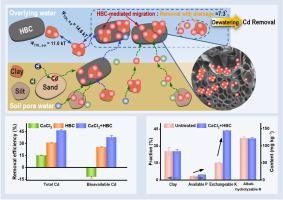Science of the Total Environment ( IF 8.2 ) Pub Date : 2021-10-08 , DOI: 10.1016/j.scitotenv.2021.150872 Yao Shi 1 , Zezhou Zhao 1 , Yi Zhong 1 , Huijie Hou 1 , Jing Chen 1 , Linling Wang 1 , Xiaohui Wu 1 , John C Crittenden 2

|
The utilization of recycled biochar combined with chemical leaching is an appropriate method to remove cadmium (Cd) from paddy soil. Some Cd-rich soil clay particulates (particulate Cd) are reported to be removed via biochar adsorption and the potential impact of biochar on soil properties need further study. The removal efficiencies and mechanisms of Cd from soil by using floatable hydroxyapatite modified biochar (HBC) combined with CaCl2 were studied. Synergetic removal efficiencies of total Cd (46.5%) and bioavailable Cd (37.9%) from the paddy soil were achieved with 2% HBC and 1 mM CaCl2. The increased soluble Cd in soil pore water by CaCl2 leaching could be efficiently adsorbed on HBC, and removed by HBC collection, reducing the risk of the residual soluble Cd in soil pore water to rice plants caused by the inefficient drainage in the field. The suspendability of clay particulates in overlying water was little affected by the low-level CaCl2 based on Derjaguin-Landau-Verwey-Overbeek (DLVO) calculation. Moreover, low-level CaCl2 facilitated the accumulation of particulate Cd on the floating HBC via decreasing the interaction energy (by 25%) between clay particulates and HBC. HBC-mediated Cd migration contributed ~70% of total Cd removal, while soluble and particulate Cd removed through the drainage accounted for ~30%. Soil clay proportion maintained at 25.3% due to the replenishment of HBC residues. In addition, soil nutrient and physicochemical conditions were improved with HBC residues. This work provides a novel soil remediation method by using floatable biochar combined with low-level CaCl2 for Cd-contaminated paddy soil remediation.
中文翻译:

可漂浮羟基磷灰石改性生物炭吸附和低浓度CaCl2浸出对水稻土Cd去除的协同作用
利用再生生物炭与化学浸出相结合是去除稻田中镉(Cd)的合适方法。据报道,一些富含 Cd 的土壤粘土颗粒(颗粒 Cd)可通过生物炭吸附去除,生物炭对土壤性质的潜在影响需要进一步研究。研究了可漂浮的羟基磷灰石改性生物炭(HBC)与CaCl 2结合去除土壤中Cd的效率和机制。使用 2% HBC 和 1 mM CaCl 2实现了稻田土壤中总 Cd (46.5%) 和生物可利用 Cd (37.9%) 的协同去除效率。CaCl 2增加土壤孔隙水中可溶性Cd浸出物可有效吸附在 HBC 上,并通过 HBC 收集去除,降低了田间排水不畅导致土壤孔隙水中残留的可溶性 Cd 对水稻植株的风险。根据 Derjaguin-Landau-Verwey-Overbeek (DLVO) 计算,粘土颗粒在上覆水中的悬浮性几乎不受低浓度 CaCl 2的影响。此外,低浓度 CaCl 2通过降低粘土颗粒和 HBC 之间的相互作用能(降低 25%),促进了颗粒 Cd 在漂浮的 HBC 上的积累。HBC 介导的 Cd 迁移占 Cd 总去除量的约 70%,而通过排水去除的可溶性和颗粒 Cd 占约 30%。由于 HBC 残留物的补充,土壤粘土比例保持在 25.3%。此外,HBC 残留物改善了土壤养分和理化条件。本工作为利用可漂浮生物炭结合低浓度CaCl 2修复Cd污染稻田土壤提供了一种新的土壤修复方法。











































 京公网安备 11010802027423号
京公网安备 11010802027423号